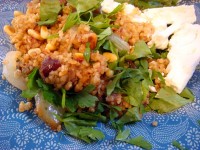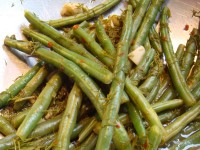Podcast: Play in new window | Download
This week, it’s that old-school standby, sloppy joes. On good crusty bread with an interesting side salad, it makes a very easy, very satisfying dinner.
Shopping list
-
- Butter
-
- Crusty sourdough bread
-
- Ground beef (1 lb. for 4 people)
-
- 1 medium onion
-
- Ketchup (1/2 cup)
-
- Red wine vinegar (about 1/2 cup)
-
- Brown sugar (couple tablespoons)
-
- Dry mustard, or regular dijon-style mustard (couple tablespoons)
-
- Ground cloves or whole cloves
-
- Celery seed
-
- Lettuce
-
- Radishes
-
- Avocado
-
- Basil
-
- Yogurt, ideally thick Greek-style (about 1/4 cup)
-
- Mayonnaise (big spoonful)
-
- Miso OR anchovies
-
- Lemon (one)
- Salt and pepper
Sloppy Joes
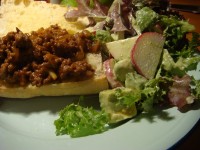 Nothin’ fancy about these guys. But they are shockingly easy, they use almost no fresh ingredients (not a goal, obviously, but it’s good to have a few dishes like this in your repertoire) and, most important, they taste great.
Nothin’ fancy about these guys. But they are shockingly easy, they use almost no fresh ingredients (not a goal, obviously, but it’s good to have a few dishes like this in your repertoire) and, most important, they taste great.
For about 4 servings
1 medium yellow onion
1 tbsp butter
Salt
1 pound ground beef, not too lean
1/2 cup ketchup
1/4 cup red wine vinegar
2 tbsp brown sugar
2 tbsp dry mustard or prepared Dijon-style mustard
1/2 tsp celery seed
1/4 tsp ground clove, or 5 or 6 whole cloves
Salt and pepper
For serving:
Good crusty sourdough bread or rolls
Butter
Preheat your oven to 400 degrees. Set a heavy skillet on the stove on medium-high to preheat while you chop your onion into rough dice. Melt the butter in the hot pan, then add the onions and stir to coat well. Add a good pinch of salt. Turn the heat down to medium and let the onions soften up while you mix the ketchup, vinegar, sugar, mustard, celery seed and cloves together in a large measuring cup. Add another big pinch of salt and some grinds of black pepper if you like.
When the onions are translucent, or even a little brown, add the ground beef, breaking it into pieces with the edge of your spoon. You want the meat crumbled up fairly well, but a few larger pieces are OK for variety. Pour in the ketchup-etc. mix. Give your measuring cup a rinse with a couple tablespoons of water and pour that in too. Once the mix is bubbling, turn the heat down to medium-low and put a lid on the pan. Depending on your stove and what else you’re doing, you may want the heat on its very lowest setting.
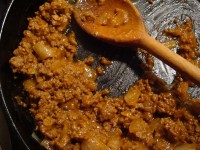 Simmer about 20 minutes, until the flavors blend and there’s a nice sauce around the meat. (If you get distracted and the sauce cooks away, you can add a couple tablespoons more water and let it simmer again for another five minutes or so.)
Simmer about 20 minutes, until the flavors blend and there’s a nice sauce around the meat. (If you get distracted and the sauce cooks away, you can add a couple tablespoons more water and let it simmer again for another five minutes or so.)
About 10 minutes before the sloppy joes are done, stick your bread in the oven to heat up — if it’s fresh, splash it with a bit of water to make the crust extra-crispy.
Serve on hot buttered bread or rolls.
Green Salad with Radishes, Avocados and Creamy Basil Dressing
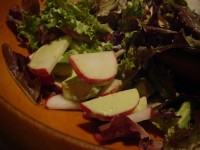 Smooth, nutty avocados combine nicely with crispy, peppery radishes. I didn’t have them on hand for the podcast, but thinly slice red onions or chives would also be a good addition to this salad.
Smooth, nutty avocados combine nicely with crispy, peppery radishes. I didn’t have them on hand for the podcast, but thinly slice red onions or chives would also be a good addition to this salad.
For the dressing, miso and anchovies serve the same purpose: an underlying saltiness and body. Use whatever you happen to have on hand, or invest in one or both. A tub of miso lasts for months, perhaps years, in the fridge, as do anchovies. You could also use other herbs–parsley, mint, tarragon–though probably in slightly smaller quantities.
For 2 generous servings
Half a head of lettuce
4 or 5 medium radishes
1 avocado
For the dressing:
2 heaping spoons thick Greek-style yogurt (or a bit more regular yogurt)
1 heaping spoon mayonnaise
1 large handful fresh basil
1 teaspoon miso, or 1 or 2 anchovy fillets, or a big squeeze of anchovy paste
Juice from half a lemon or lime
1-2 tsp apple cider vinegar
Salt, perhaps
Rinse your lettuce and arrange in a bowl. Chop up the radishes and avocados as you see fit. (Slicing rounds of radishes is extra-pretty, but difficult to keep stable on your cutting board–that’s why I usually do half-rounds, as the flat side makes them easier to slice.)
Combine all the ingredients except the salt in a blender and whiz to combine. Taste for salt–whether you want or need it depends on your miso or anchovies. If the mix is tarter than you want, add a dollop more mayonnaise and reblend. Pour the mix over your salad and serve.

